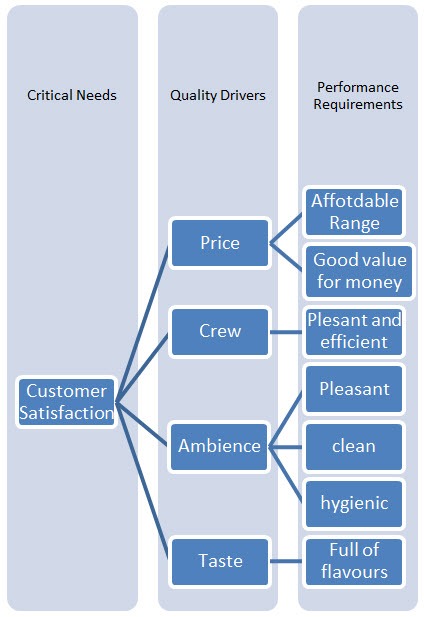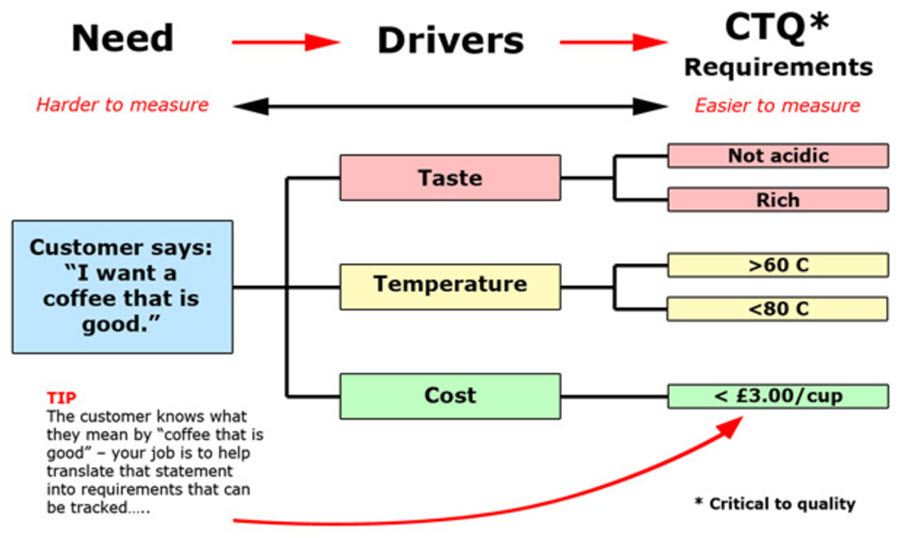CTQ is the abbreviated term for Critical to Quality. CTQ tree is a Six Sigma tool that is based on diagrams and helps to manufacture and provide superior quality products to customers. CTQ trees are used to interpret extensive and broader customer requirements into particular, precise, litigable and calculable performance demands.
While formulating new products quality is the most important factor not only for customer’s satisfaction but also to stick out from your competitors. CTQ trees are very helpful in this regards as they define quality from customer’s point of view. Most excellent approach is to design a CTQ tree for every singular need, as it results in a thorough and complete list of demands and requirements that are required to provide a superior quality product for customer’s satisfaction. In this article we will review a CTQ tree example and explain how it can improve your business.
Components of CTQ Tree
CTQ tree is build up with following three main components.
Need
It highlights the customer requirements and it is the origin of a CTQ tree. For example, for a fast food restaurant, customer’s need is fast food.
Driver
Drivers are the parameters on which a customer judges the quality of product.
Requirements
These are the calculable performance specifications that have to be met by drivers to satisfy clients. It helps the quality teams to measure quality of a product and service and make sure it meets client’s demands.
In order to make an effective and efficient CTQ tree, it is necessary to identify all the above components perfectly.
Steps for CTQ Tree Development
There are some important and necessary steps that are required for making an effective Critical to Quality tree. These are:
- Detect voice of customer
- Recognize customer demand specifications
- Prioritize the specifications
- Transform customer demands into CTQ
Detect Voice of Customer
To detect the voice of customer (VOC) or business is the initial and fundamental system in CTQ tree development. It is the procedure to gather customer’s feedback. Voice of customer (VOC) can be identified by many ways like surveys, complaints, interviews etc.
Recognize customer demand specifications
The data collected in form of Voice of Customer is in rough and basic form and it needs to be processed efficiently to transform it into customer demands. It can be achieved by gathering a team of experts to analyze VOCs and recognize customer demand specifications and parameters.
Prioritize the specifications
After the customer requirements are identified and analyzed it is really important for the expert team to prioritize these needs and specifications on basis of their criticality. This step is not given much importance in some of the organizations but it should be considered as a significant feature. KANO model is considered helpful in this regard.
Transform customer demands into CTQ
This is the final and most important step in development of Critical to Quality tree. It is considered as nucleus of this activity. The customer requirements that were identified earlier are transformed into quantifiable parameters. This helps to set a focus point for the expert squad to efficiently ratify the product or service according to customer requirements.
CTQ Tree Example
To make things understandable, let us take a CTQ tree example of going to a pizzeria.
Whenever someone visits a pizzeria, all they want is to have an amazing experience and be a satisfied customer. For this there are a few drivers that may be.
- Price
- Crew or workforce
- Ambience
- Taste
These are the drivers for which the owners have to meet customer’s requirements in order to have a satisfied customer. Below is a CTQ tree example diagram. In this way it gives us a clear understanding of what requirements need to be met for customer satisfaction.

First of all critical needs are identified and for each need quality drivers are recognized. Then performance requirements for each drive are identified.
Benefits of CTQ
- CTQ helps to identify solitary needs of the individual client and recognize measurable performance requirements needed for specific client’s satisfaction.
- CTQ highlights any weak areas in an organization where performance is below standard and helps in root cause analysis.
CTQ helps in quality improvement of a product or service.






